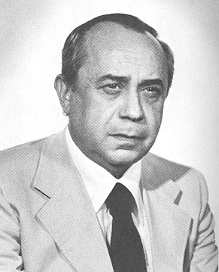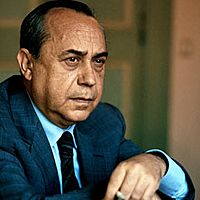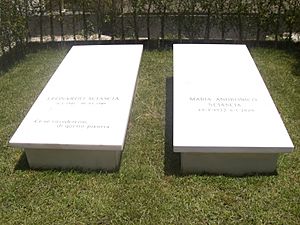Leonardo Sciascia facts for kids
Quick facts for kids
Leonardo Sciascia
|
|
|---|---|
 |
|
| Member of the Chamber of Deputies | |
| In office 20 June 1979 – 10 July 1983 |
|
| Member of the European Parliament for Southern Italy |
|
| In office 10 June 1979 – 16 June 1984 |
|
| Personal details | |
| Born | 8 January 1921 Racalmuto, Sicily, Kingdom of Italy |
| Died | 20 November 1989 (aged 68) Palermo, Sicily, Italy |
| Political party | Italian Communist Party (1975–1977) Radical Party (1979–1984) |
| Residences | Palermo, Sicily |
| Profession | Writer, novelist, journalist, political activist |
Leonardo Sciascia (Italian pronunciation: [leoˈnardo ʃˈʃaʃʃa]; 8 January 1921 – 20 November 1989) was an Italian writer, novelist, essayist, playwright, and politician. Some of his works have been made into films, including Porte Aperte (1990; Open Doors), Cadaveri Eccellenti (1976), Todo Modo (also 1976) and Il giorno della civetta (1968; The Day of the Owl).
Contents
Biography
Sciascia was born in Racalmuto, Sicily, on 8 January 1921. In 1935, his family moved to Caltanissetta, where Sciascia studied under Vitaliano Brancati, who would become his model in writing and introduce him to French novelists. From Giuseppe Granata, future Communist member of the Italian Senate, Sciascia learned about the French Enlightenment and American literature. In 1944, he married Maria Andronico, an elementary school teacher in Racalmuto. In 1948, his brother died, an event which profoundly impacted Sciascia.
Sciascia's first work, Favole della dittatura (Fables of the Dictatorship), a satire on fascism in Italy, was published in 1950. This was followed in 1952 by La Sicilia, il suo cuore (Sicily, its Heart), his first and only poetry collection, illustrated by Emilio Greco. The following year Sciascia won the Premio Pirandello, awarded by the Sicilian Region, for his essay "Pirandello e il pirandellismo" ("Pirandello and Pirandellism").
In 1954, he began collaborating with literature and ethnology magazines published by Salvatore Sciascia in Caltanissetta. In 1956, he published Le parrocchie di Regalpetra (The Parishes of Regalpetra), an autobiographic novel inspired by his experience as an elementary school teacher in his home town. In the same year he moved to teach in Caltanissetta, only to move again to Rome in 1957 where he struck up a lifelong friendship with Sicilian artist, Bruno Caruso. In the autumn of 1957 he published Gli zii di Sicilia (Uncles of Sicily), which includes sharp views about themes such as the influence of the U.S. and of communism in the world, and the 19th century unification of Italy.
After one year in Rome, Sciascia moved back to Caltanissetta, in Sicily. In 1961, he published the mystery Il giorno della civetta (The Day of the Owl), one of his most famous novels, and in 1963, the historical novel Il consiglio d'Egitto (The Council of Egypt), set in 18th-century Palermo. After a series of essays, in 1965 he wrote the play L'onorevole (The Honorable), a denunciation of the complicities between government and the mafia. Another political mystery novel is 1966's A ciascuno il suo (To Each His Own).
The following year Sciascia moved to Palermo. In 1969, he began a collaboration with Il Corriere della Sera. That same year he published the play Recitazione della controversia liparitana dedicata ad A.D. (Recitation of liparitana dispute dedicated to A.D.), dedicated to Alexander Dubček. In 1971, Sciascia returned again to mystery with Il contesto (The Challenge), which inspired Francesco Rosi's movie Cadaveri eccellenti (1976). The novel created Polemics, due to its merciless portrait of Italian politics, as did his novel Todo modo (1974; One Way or Another), due to its description of Italy's Catholic clergy.
At the 1975 communal elections in Palermo, Sciascia ran as an independent within the Italian Communist Party (PCI) slate and was elected to the city council. In the same year, he published La scomparsa di Majorana (The Disappearance of Majorana), dealing with the mysterious disappearance of scientist Ettore Majorana. In 1977, he resigned from PCI, due to his opposition to any dealing with the Democrazia Cristiana (Christian Democratic party). Later, he would be elected to the Italian and European Parliament with the Radical Party.
Sciascia's last works include the essay collection Cronachette (1985), the novels Porte aperte (1987; Open Doors) and Il cavaliere e la morte (1988; The Horseman and Death). He died in June 1989 at Palermo.
Work summary
A number of his books, such as The Day of the Owl (Il giorno della civetta) and Equal Danger (Il contesto), demonstrate how the Mafia manages to sustain itself in the face of the anomie inherent in Sicilian life.
Sciascia's work is intricate and displays a longing for justice, while attempting to show how corrupt Italian society had become and remains. His linking of politicians, intrigue, and the Mafia gave him a high profile, which was very much at odds with his private self. This high-profile resulted in his becoming widely disliked for his criticism of Giulio Andreotti, then Prime Minister, for his lack of action to free Moro and answer the demands of the Brigate Rosse (Red Brigades).
Sciascia wrote of his unique Sicilian experience, linking families with political parties, the treachery of alliances and allegiances, and the calling of favors that result in outcomes that do not benefit society, but those individuals who are in favor. His books are rarely characterized by a happy ending or by justice for the ordinary man. A prime example of this is Equal Danger (1973; Il Contesto), in which the police's best detective is drafted to Sicily to investigate a spate of murders of judges. Focusing on the inability of authorities to handle such investigation into the corruption, Sciascia's hero is finally thwarted.
His 1984 opus, Occhio di Capra (Goat's Eye), is a collection of Sicilian sayings and proverbs gathered from the area around his native village, to which he was intensely attached throughout his life.
Works
- Le favole della dittatura (1950)
- La Sicilia, il suo cuore (1952)
- Il fiore della poesia romanesca. Belli, Pascarella, Trilussa, Dell'Arco (1952)
- Pirandello e il Pirandellismo (1953)
- Le Parrocchie di Regalpetra (1st ed. 1956, 2nd augmented ed. 1963) (Salt in the Wound, trans. Judith Green (1969))
- Gli zii di Sicilia (1st ed. 1958, 2nd augmented ed. 1961) (Sicilian Uncles, trans. N.S. Thompson (1986)) – short stories
- Il Giorno della Civetta (1961) (Mafia Vendetta, trans. Archibald Colquhoun and Arthur Oliver (1963); republished as The Day of the Owl (1984))
- Pirandello e la Sicilia (1961)
- Il consiglio d’Egitto (1963) (The Council of Egypt, trans. Adrienne Foulke (1966))
- Santo Marino (1963)
- Morte dell'inquisitore (1964) (Death of the Inquisitor, trans. Judith Green (1969); Death of an Inquisitor and other stories, trans. Ian Thomson (1990) (published with translations of Cronachette (1985) and Le strega e il capitano (1986))
- L'onorevole (1965)
- Jaki (1965)
- A ciascuno il suo (1966) (A Man's Blessing, trans. Adrienne Foulke (1968); republished as To Each His Own (1992))
- Racconti siciliani (1966)
- Recitazione della controversia liparitana dedicata ad A.D. (1969)
- La corda pazza (1970)
- Atti relativi alla morte di Raymond Roussel (1971)
- Il contesto. Una parodia (1971) (Equal Danger, trans. Adrienne Foulke (1973))
- Il Mare Colore del Vino (1973) (The Wine-Dark Sea, trans. Avril Bardoni (1985)) – collected short stories
- Todo Modo (1974) (One Way or Another, trans. Adrienne Foulke (1977); Sacha Rabinovich (1987))
- La Scomparsa di Majorana (1975) (The Mystery of Majorana, trans. Sacha Rabinovich (1987))
- I pugnalatori (1976)
- Candido, ovvero, un sogno fatto in Sicilia (1977) (Candido, or A Dream Dreamed in Sicily, trans. Adrienne Foulke (1979))
- L'affaire Moro (1st ed. 1978, 2nd augmented ed. 1983) (The Moro Affair, trans. Sacha Rabinovich (1987))
- Dalle parti degli infedeli (1979)
- Nero su nero (1979)
- Il teatro della memoria (1981)
- La sentenza memorabile (1982)
- Cruciverba (1983)
- Stendhal e la Sicilia (1984)
- Occhio di capra (1st ed. 1984, 2nd augmented ed. 1990)
- Cronachette (1985) (Little Chronicles trans. Ian Thomson (1990) (published with translations of Morte dell'inquisitore (1964) and Le strega e il capitano (1986))
- Per un ritratto dello scrittore da giovane (1985)
- La strega e il capitano (1987) (The Captain and the Witch, trans. Ian Thomson (1990) (published with translations of Morte dell'inquisitore (1964) and Cronachette (1985)
- 1912+1 (1986) (1912 + 1, trans. Sacha Rabinovitch (1989))
- Porte Aperte (1987) (Open Doors, trans. Marie Evans (1991))
- Il Cavaliere e la Morte (1988) (The Knight and Death, trans. Joseph Farrell (1991))
- Alfabeto pirandelliano (1989)
- Fatti diversi di storia letteraria e civile (1989)
- Una storia semplice (1989) (A Straightforward Tale, trans. Joseph Farrell (1991); A Simple Story, trans. Howard Curtis (2010))
- A futura memoria (se la memoria ha un futuro) (1989)
See also
 In Spanish: Leonardo Sciascia para niños
In Spanish: Leonardo Sciascia para niños




